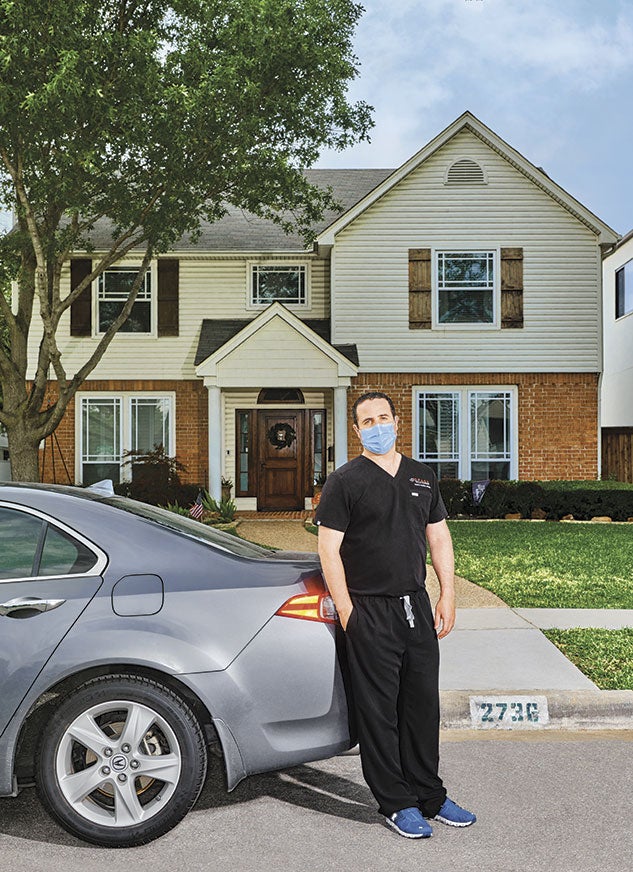Mission Critical
As a critical pulmonary care physician with a graduate degree in public health, I’m used to having evidence-based answers; COVID-19’s questions are entirely new.

I am a critical pulmonary care physician, which means that I manage the most critically ill patients in the hospital — generally, patients who have multiple organ failure. Because they are so sick, many of them end up on a ventilator. With pneumonia and other respiratory diseases, patients might be on the ventilator for four or five days. The problem with the new coronavirus is that patients are spending 14, 15, 16 days on the ventilator. Because they haven’t been moving around, their muscles atrophy, including the muscles that help them breathe. I have one COVID-19 patient who has been on a ventilator for four weeks. Fortunately, we have enough ventilators at the moment.
I work in five Dallas-area hospitals, and each of them has a designated hot zone for COVID-19 patients. Before going into that area, we put on our personal protective equipment (PPE) in an anteroom. There’s a nursing tech who monitors and coaches us to make sure we’re donning and doffing the equipment in the right order. It takes about 15 minutes. The equipment is meant to be single use, but because of shortages we’re wearing it for extended shifts. That means you have to make sure it’s comfortable to wear for a long period of time. It’s even more dangerous taking off the PPE because you don’t want to contaminate yourself. After every piece of equipment you take off, you have to wash your hands and put on a new pair of gloves.
The car I drive to work is now the “corona” car — I don’t use it for anything else. I take off my shoes before I get home. We have an outdoor shower, and that’s where I clean up every night. I put my scrubs in a laundry hamper, shower outside and put on new clothes before going inside. The temperature was in the 50s last week, so it was definitely a chilly shower.
My schedule is seven days on, a weekend off, seven more days on and then a week off. When I’m working, I complete 11-hour shifts and I’m on call for 24 hours. Off weeks still feel the same, except that a day before I go back to work I get a little more nervous than usual.
I’m still living at home with my wife and daughter, but I know doctors who are sleeping in guest rooms or even a different house from the rest of their family. My wife is pregnant — that’s scary. Not only am I going out there and risking my life, but possibly also my family’s lives. It’s heavy at some points.
I don’t think anyone’s ever prepared for this kind of crisis. I’ve dealt with one mass casualty event before, but that only lasted a day or two. I have a Master of Public Health degree in tropical medicine, so I’ve studied infectious diseases, and I regularly deal with HIV, hepatitis C and tuberculosis. But those aren’t nearly as contagious as the coronavirus. One of the challenges in treating COVID-19 is that I was trained in evidence-based medicine; every therapy I give has been proven to work. We don’t have established data on the best way to fight COVID-19. That’s what’s scary. Am I doing the right treatment? Let’s say my friend is using some other treatment — is that something I should consider? I’m not used to being both a doctor and a scientist at the same time.
As a critical care doctor, you know some of your patients won’t survive, but at least you can be there with the family — that’s a big part of the job. Right now, though, no visitors are being allowed into hospitals. Only at the end of life, or if we’re withdrawing life support, do we allow a family member in. I spend a lot of time having phone conversations with patients’ families, which is really difficult. Some of the patients have chronic illnesses and their families have seen it coming. But in one case I was talking to the sister of a healthy 36-year-old patient who was on a ventilator, and I couldn’t say whether they were going to make it or not. I’m 35 myself. Before COVID-19, I could usually tell families what my patient’s chances of survival were. Now I just don’t know. — As told to Michael Hardy ’06
Zachary Dreyfuss ‘07 is a pulmonary and critical care physician working at the forefront of the COVID-19 pandemic. He lives in Dallas with his wife, an obstetrician and their 4-year-old daughter, and is eagerly awaiting the birth of their son in September. He fondly remembers serving as Sammy the Owl.
Michael Hardy '06 is a writer-at-large for Texas Monthly. His stories have been published in The New York Times, Wired, The New Republic, The American Scholar and elsewhere. He lives in Houston.
